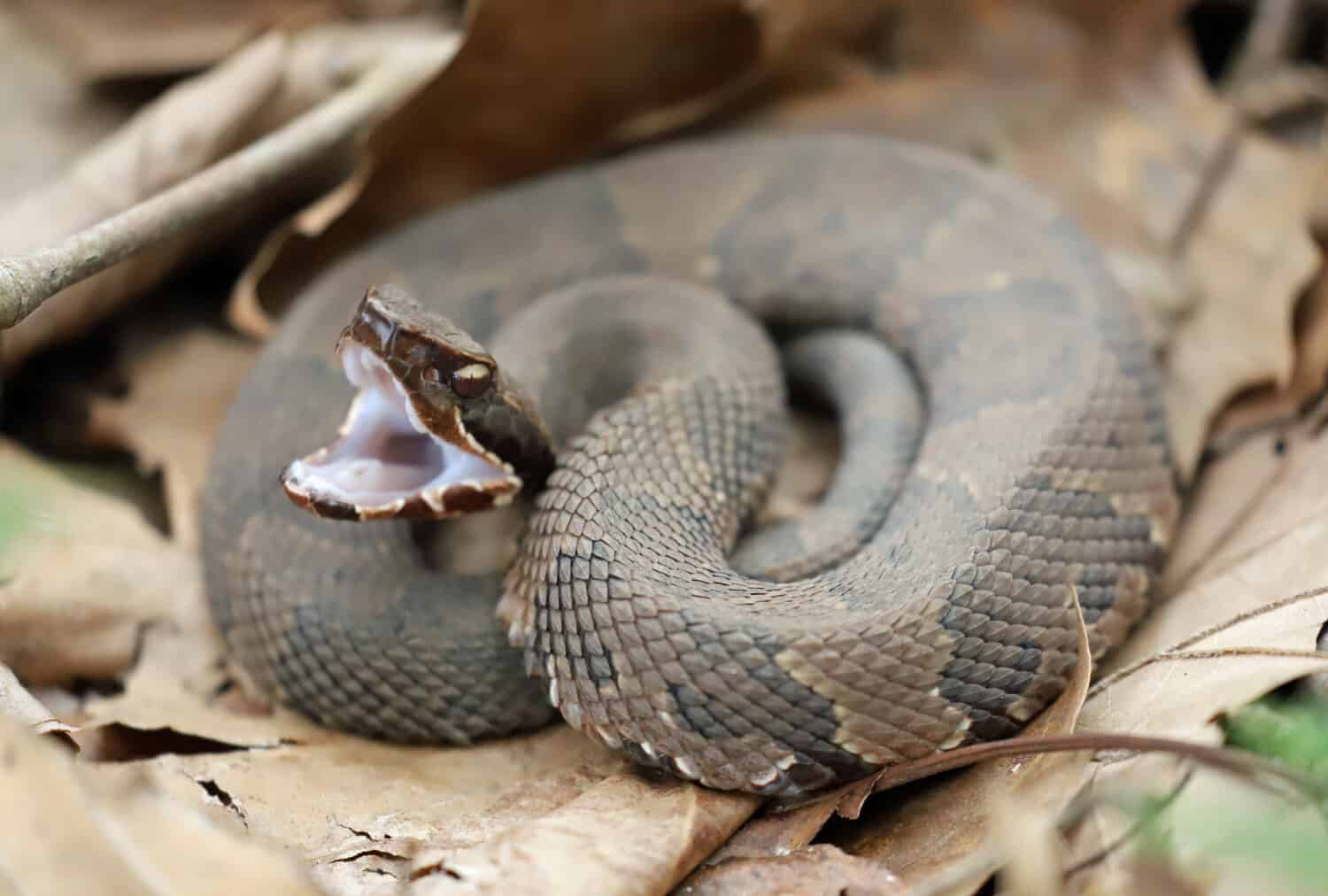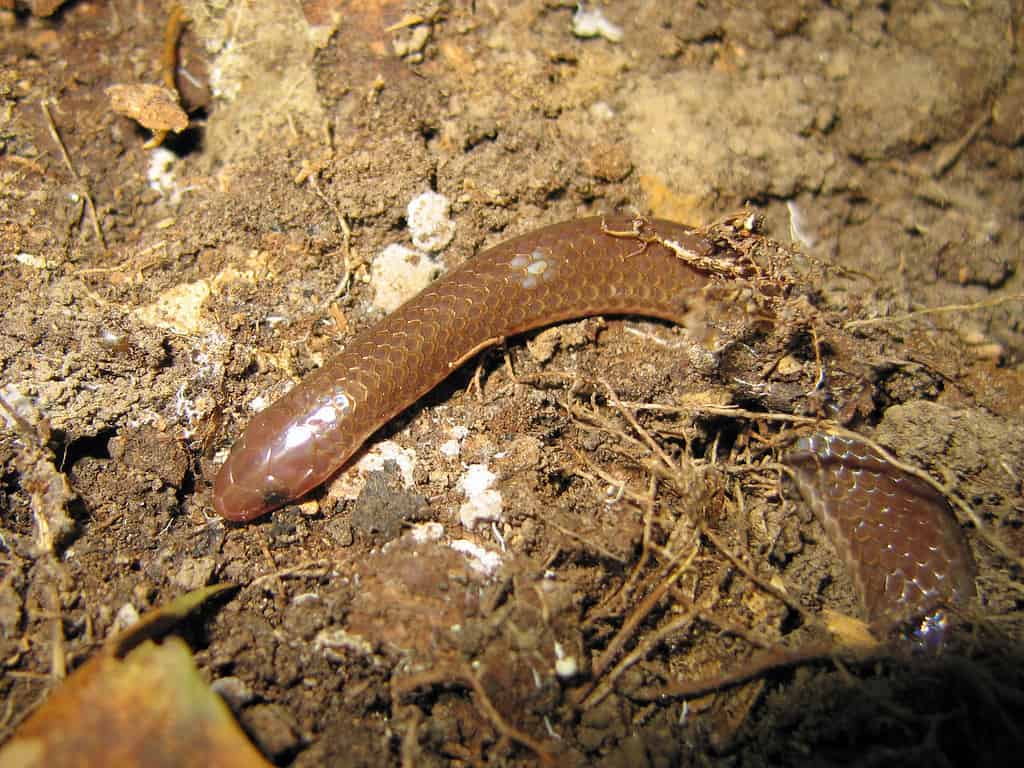If you like snakes, Illinois is a good place to go. With the notable exception of Chicago, much of the state is rural or forested and well-watered with streams and rivers. Having a generally mild climate and offering good hunting, Illinois has ideal snake habitats. As a result, according to the Illinois Department of Natural Resources, the state has 40 different species of snakes, four of which are venomous. We list them here so you can identify them the next time you’re rambling around the Illinois countryside.
Colubridae Family
This family of snakes has the most species in the world. Three things they have in common are that they have no pelvic girdle, no functioning left lung, and large scales on their heads. They lay eggs, are non-venomous, and do not hurt people.
1. Scarlet snake (Cemophora coccinea)
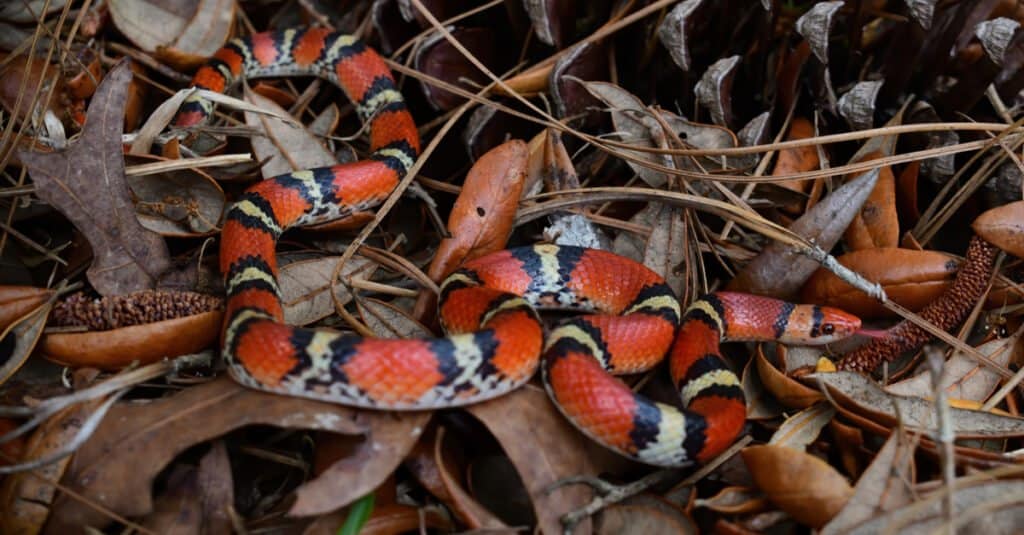
The scarlet snake has a similar appearance to the venomous coral snake.
©Chase D’animulls/Shutterstock.com
Scarlet snakes grow to 14-26 inches long. With red, black, and yellowish-white splotches on their backs, they are sometimes confused with venomous coral snakes. This no doubt helps the species survive by scaring off predators, but they are harmless to people.
2. North American Racer (Coluber constrictor)
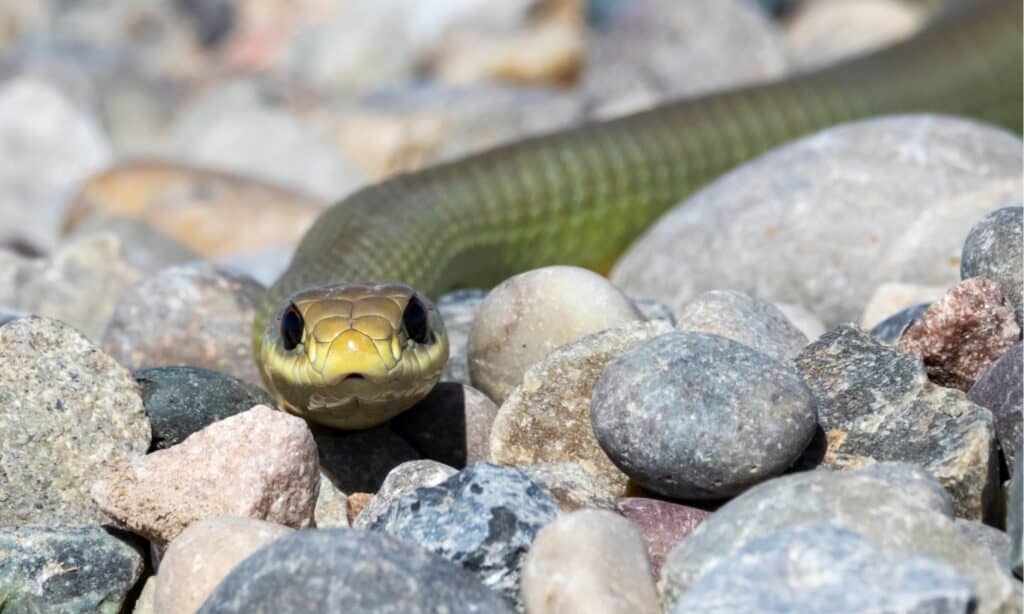
The North American racer can come in a variety of solid colors with a lighter underbelly.
©Michael Chatt/Shutterstock.com
North American racers are also known as Eastern racers. They reach a length of up to 60 inches. Racers come in a variety of solid colors: black, brown, tan, blue, or green. They have lighter-colored underbellies of white, tan, or yellow.
3. Coachwhip (Masticophis flagellum)
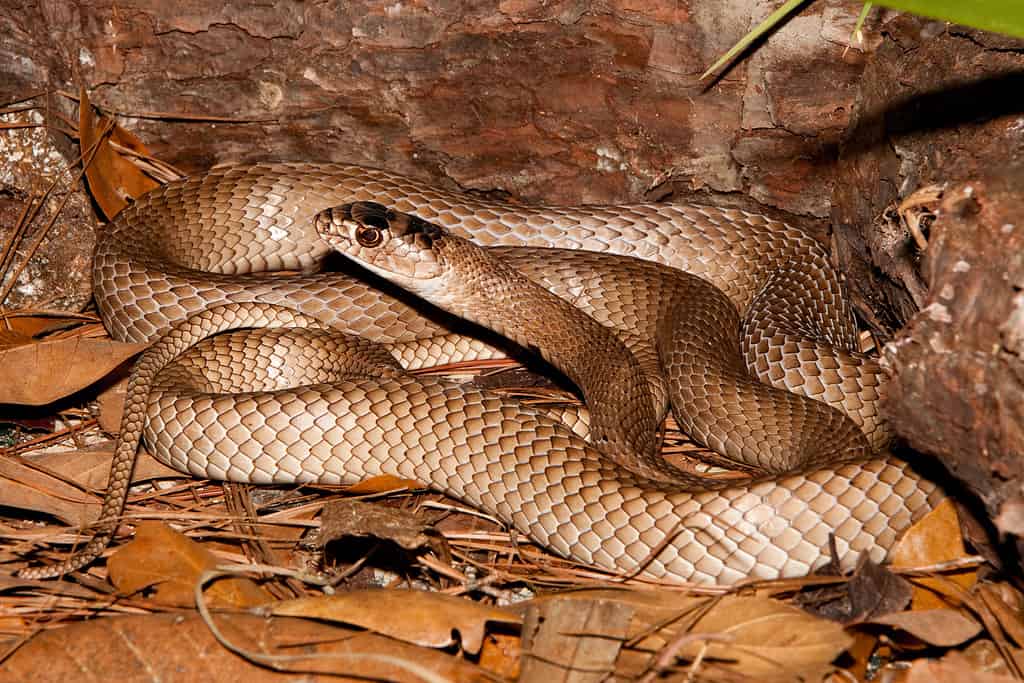
Coachwhips vary in color with their habitat.
©Jay Ondreicka/Shutterstock.com
Coachwhips have thin bodies growing up to 72 inches long. They vary in color with their habitat, ranging from light brown to pinkish red. Their scales can have a braided pattern.
4. Prairie kingsnake (Lampropeltis calligaster)
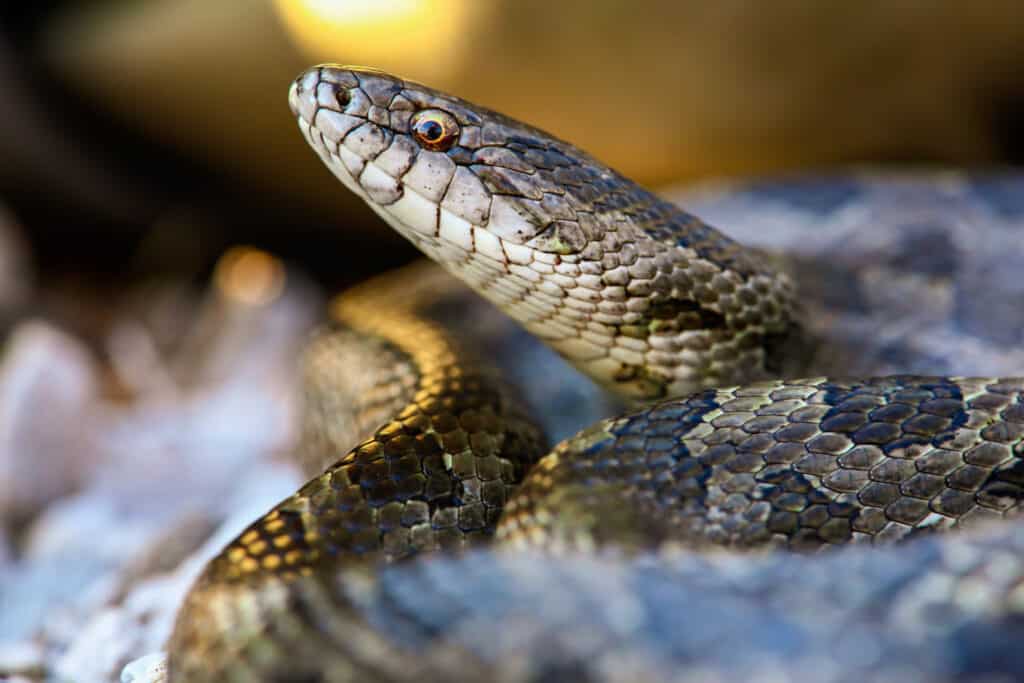
The prairie kingsnake is easy to misidentify as a rat snake.
©bradenjalexander/Shutterstock.com
This snake is often mistaken for a rat snake. Its coloration is light brown or grey with dark brown or reddish-brown blotches. They can grow up to 40 inches long.
5. Eastern Kingsnake (Lampropeltis getula)
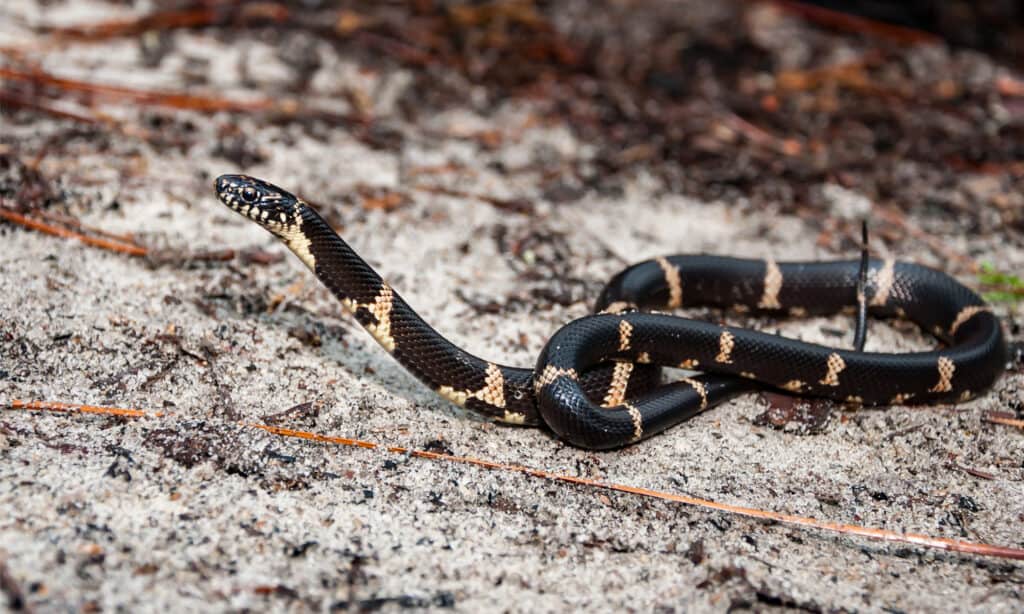
Eastern kingsnakes can grow to be quite long.
©iStock.com/JasonOndreicka
Eastern kingsnakes can grow quite large: up to 82 inches long. They are glossy black, bluish-black, or dark brown. Down the length of their bodies, they have light-colored rings of a pinkish, yellowish cream color.
6. Milk Snake (Lampropeltis triangulum)
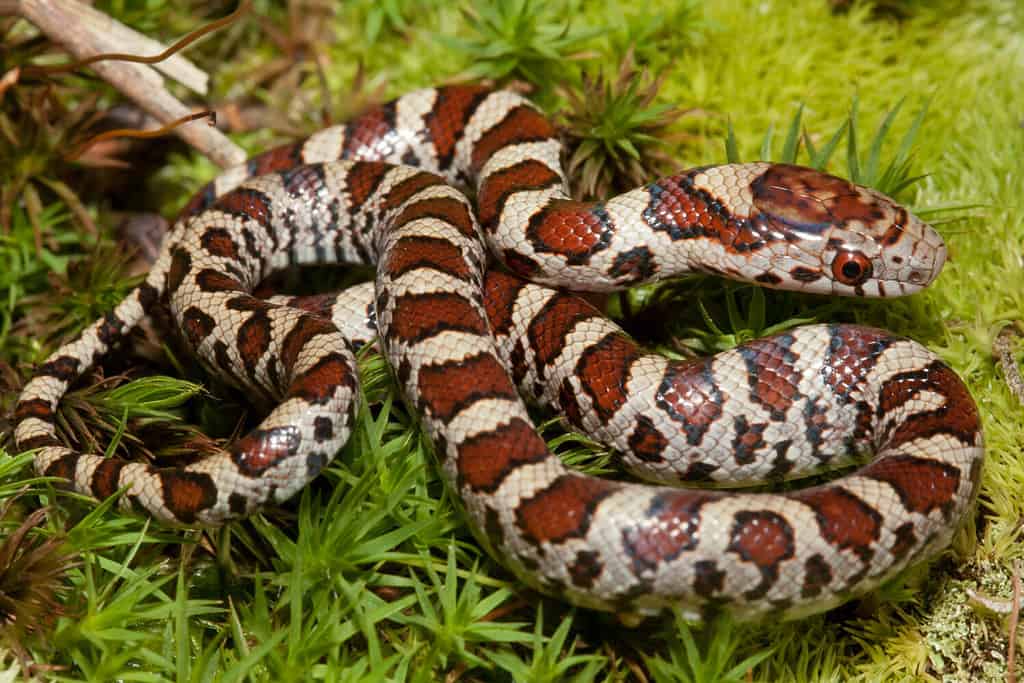
Milksnakes have color patterns similar to the venomous coral snakes.
©Nathan A Shepard/Shutterstock.com
Milk snakes come in subspecies that can range from 14-72 inches long. They are smooth and shiny, with scales in patterns of red-black-yellow or white-black-red. They are sometimes mistaken for venomous coral snakes, although the milk snake is harmless.
7. Rough Green Snake (Opheodrys aestivus)
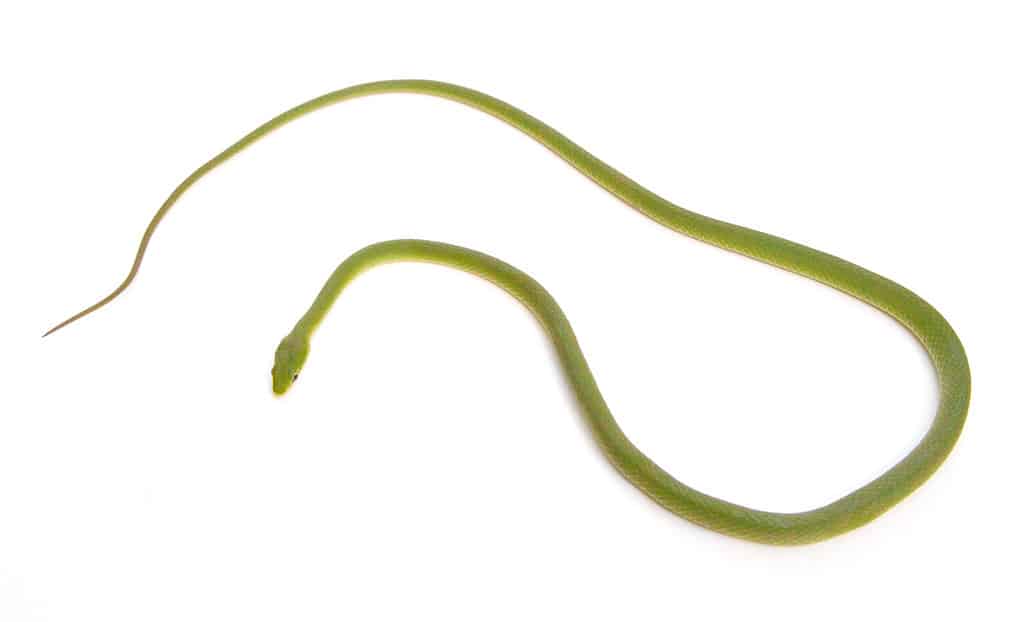
The rough green snake is a docile species that rarely bites, even when people approach it closely.
©Melinda Fawver/Shutterstock.com
The rough green snake is, as the name implies, a bright green snake with a yellowish underside. They are very thin and grow to nearly 46 inches in length. These are non-venomous snakes that allow humans to get close to them without biting. They are called “rough” green snakes because they have scales with a ridge down the center.
8. Smooth Green Snake (Opheodrys vernalis)
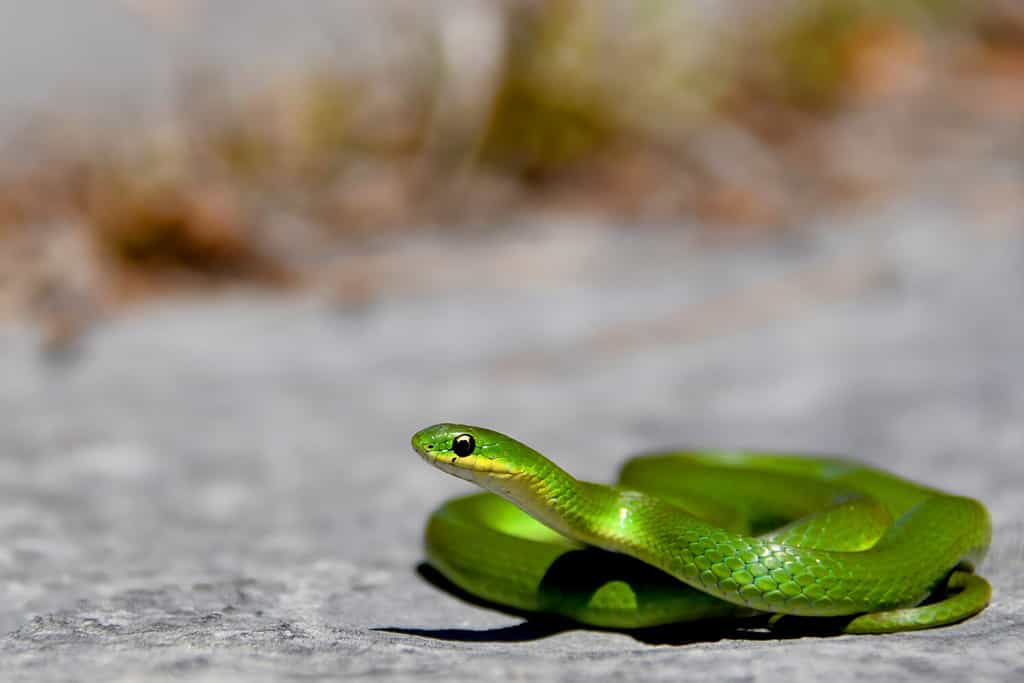
Smooth green snakes are timid and tend to flee when threatened.
©Lev Frid/Shutterstock.com
Smooth green snakes are also called grass snakes. Unlike rough green snakes, they have smooth scales. They rarely bite and try to get away when they feel threatened. They are light green on their backs with yellow or white underbelly and they can grow up to 20 inches long.
9. Great Plains Rat Snake (Pantherophis emoryi)
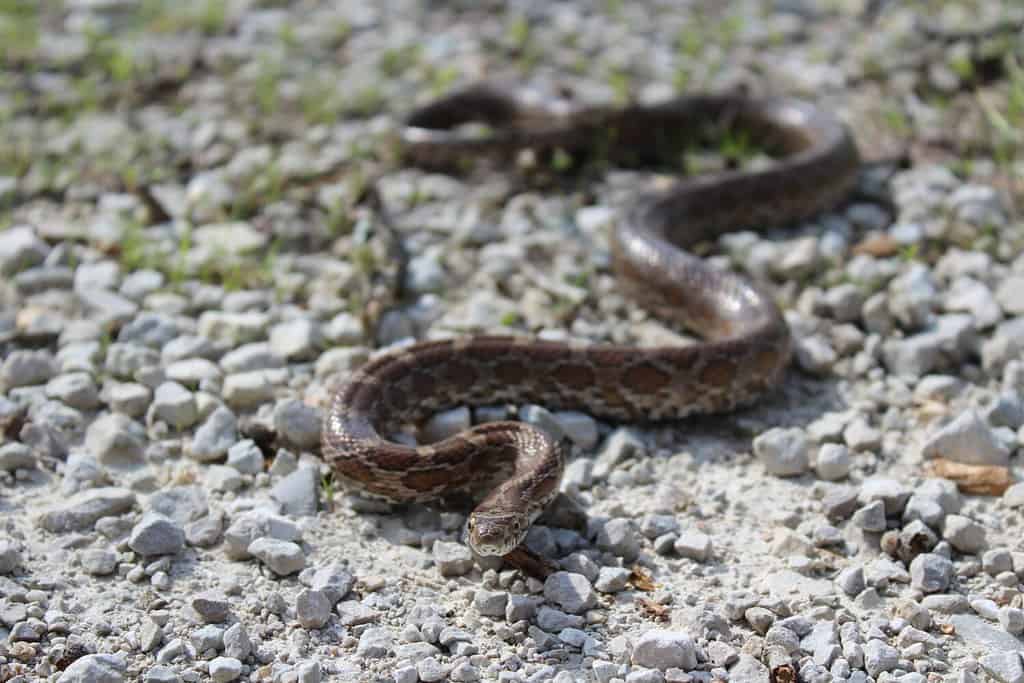
Great Plains rat snakes can grow up to 5 feet long.
©Dylan Wallace/Shutterstock.com
The Great Plains rat snake grows up to 5 feet long and is usually light gray or tan with blotches of dark gray, brown, or greenish gray down its back. They have stripes on the sides of their head that form a point between their eyes.
10. Western Fox Snake (Pantherophis ramspotti)
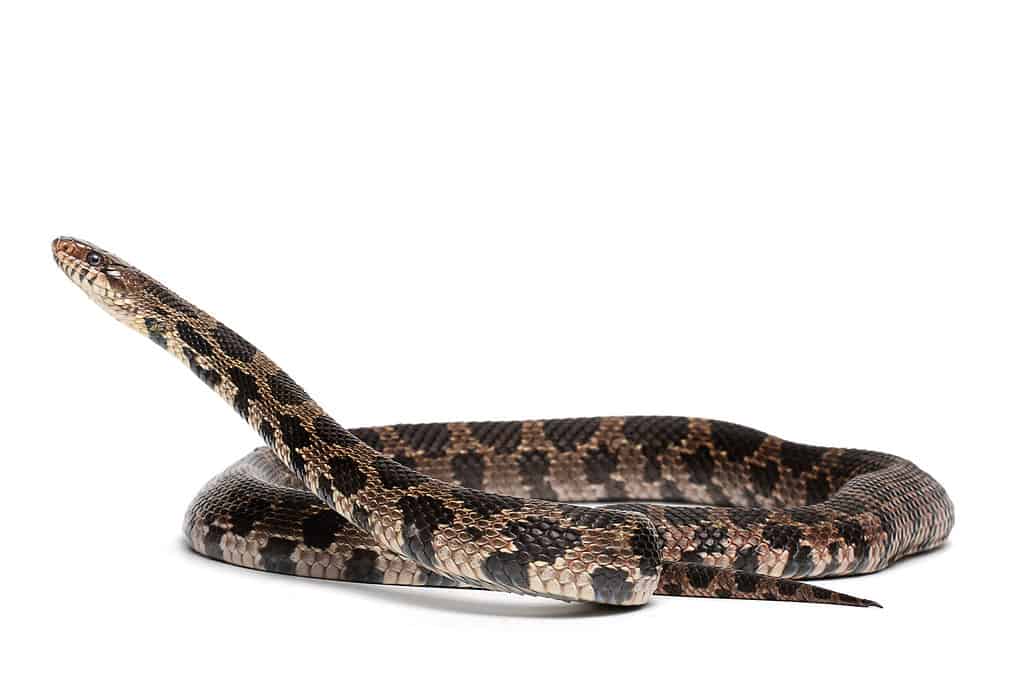
The western fox snake tries to imitate a rattlesnake to scare off its enemies.
©Michiel de Wit/Shutterstock.com
The western fox snake is a type of rat snake. It is light brown with black spots. Western fox snakes are constrictors that eat mice and other small mammals. One of their defense mechanisms is to shake their tails in imitation of a rattlesnake, go into an “S” position, and strike repeatedly to scare off their enemies.
11. Gray Rat Snake (Pantherophis spiloides)
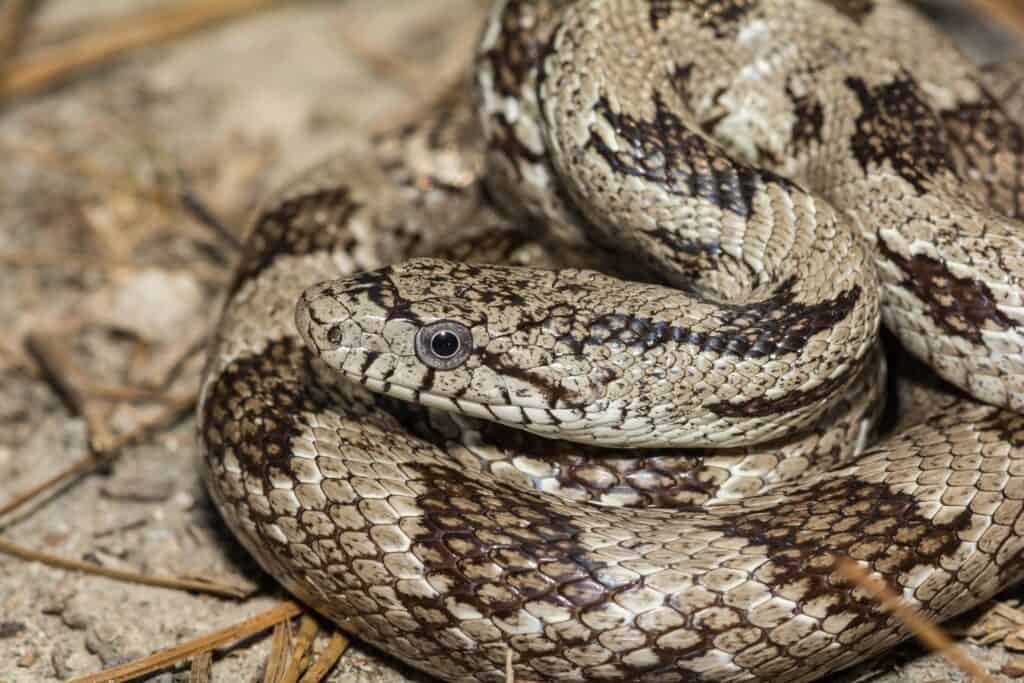
Gray rat snakes are excellent climbers. You can see them in trees or high up in barns.
©Jay Ondreicka/Shutterstock.com
Gray rat snakes grow up to 6 feet long. They are light tan with splotches of black and copper red. These snakes are good climbers and will spend time in the treetops in search of prey and to protect themselves from enemies on the ground.
12. Eastern Fox Snake (Pantherophis gloydi)

Eastern fox snakes imitate rattlesnakes as a defense mechanism.
©MLHoward/Shutterstock.com
Eastern fox snakes are a kind of rat snake that lives in wetlands and nearby meadows. To defend themselves from predators, they rattle their tails to mimic rattlesnakes. The downside of this for these snakes is that people are more likely to kill them when they mistakenly believe they are venomous.
13. Gopher Snake (Pituophis catenifer)
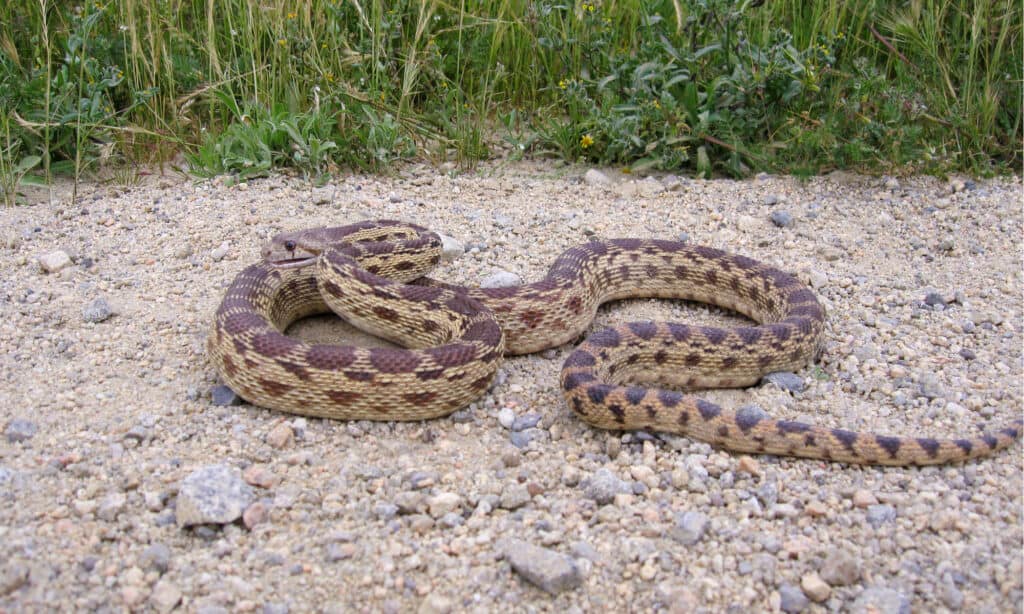
This gopher snake is coiled up and ready to strike, trying to look as much like a rattlesnake as it can.
©rawaccess/Shutterstock.com
Gopher snakes grow up to 84 inches long and are colored in a pattern of yellowish-pale brown with dark brown or black blotches on their backs. They are often confused with prairie rattlesnakes, but their heads do not have the triangular shape of rattlesnakes and they don’t have black and white bands on their tails. And of course, they don’t have rattles.
14. Flat-Headed Snake (Tantilla gracilis)
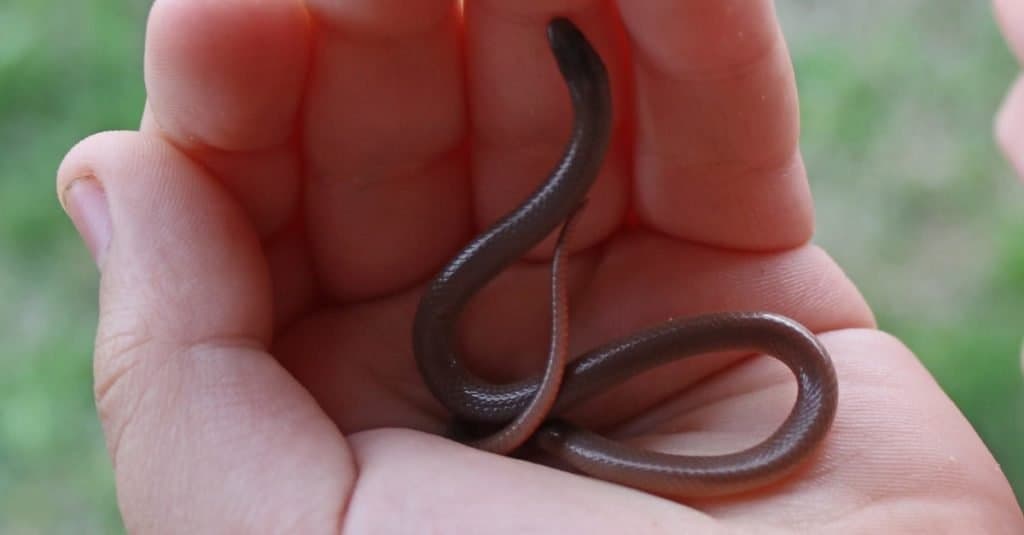
The flat-headed snake likes to burrow in moist soil under rocks or in underground burrows.
©Creeping Things/Shutterstock.com
The flat-headed snake is small, growing only to 8 inches in adulthood. They have an upturned snout that they use for digging in the soil. They have smooth scales that are tan, gray-brown, or reddish-brown. Sometimes their heads are darker. Their heads are sometimes darker than the rest of the body and they have pink bellies. The overall effect makes them look like overgrown earthworms.
Crotalidae Family
The Crotalidae family includes venomous snakes. They’re known as pit vipers because they have pits on the sides of their head that help them catch warm-blooded prey at night. Their heads are triangular, and their pupils are elliptical. Unlike other snakes, they don’t lay eggs but instead bear live young. Although their venom can be deadly if enough is injected and left untreated, most people who are bitten make a full recovery by getting timely medical attention and antivenom.
15. Eastern Copperhead (Agkistrodon contortrix)
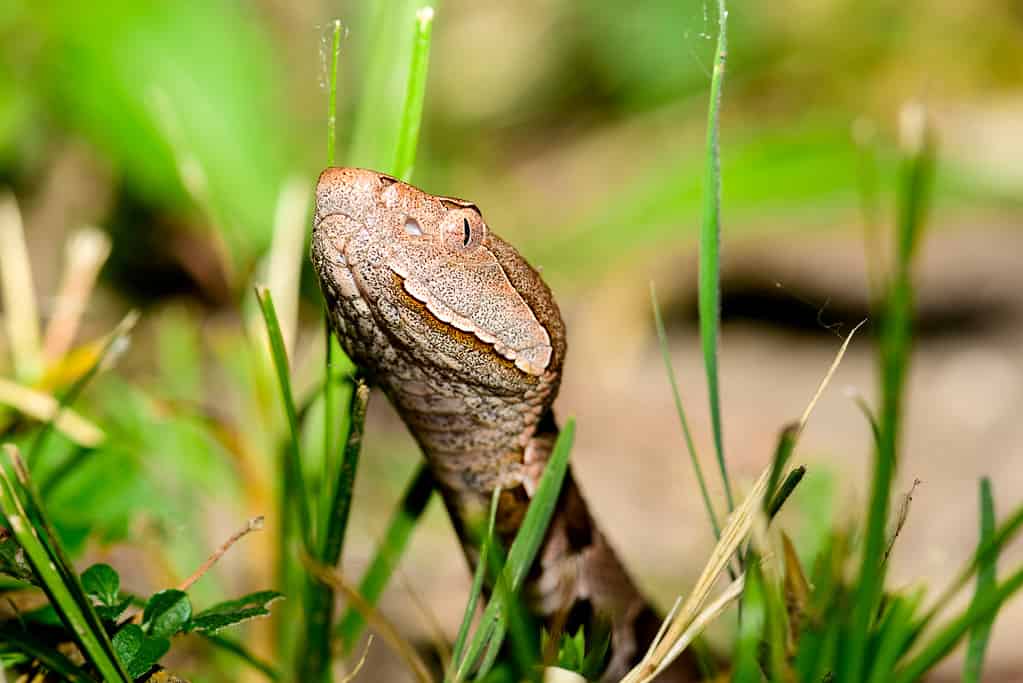
The eastern copperhead relies on camouflage. As a result, it doesn’t flee when danger approaches.
©iStock.com/JWJarrett
The eastern copperhead is a venomous snake that can grow up to 37 inches long. Their main color is a penny-copper hue with dark brown hourglass-shaped markings. They usually don’t flee when danger approaches. As a result, people are often bitten when they inadvertently step on a copperhead. Half of all the treated snakebites in the United States come from eastern copperheads.
16. Northern Cottonmouth (Agkistrodon piscivorus)
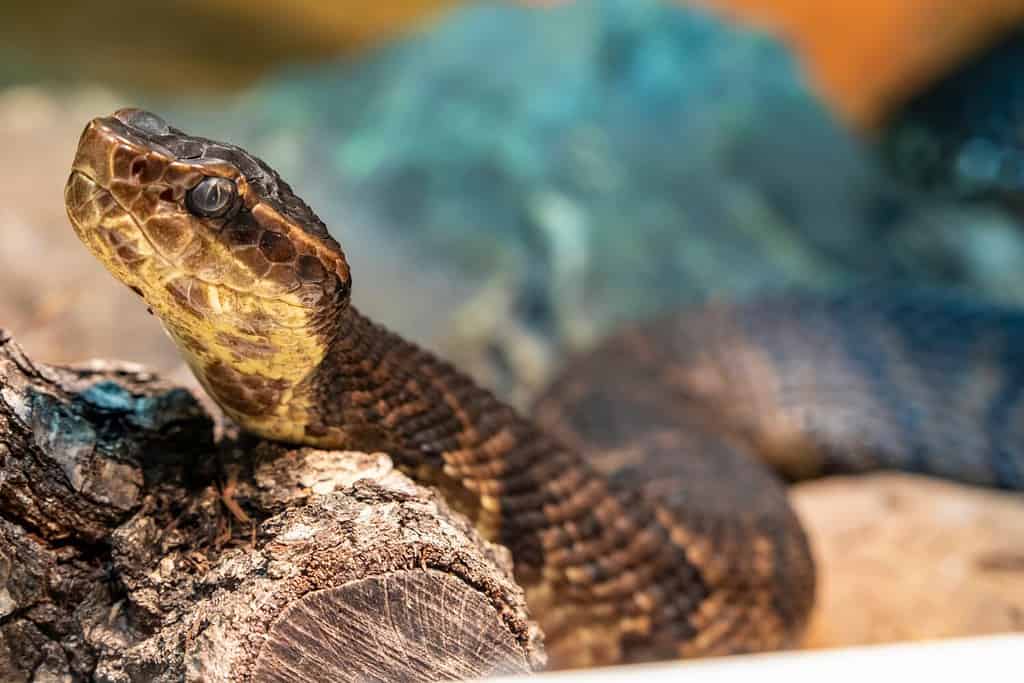
Northern cottonmouths have venom that is deadly to human beings.
©Danny Ye/Shutterstock.com
Northern cottonmouths are thick snakes that range in color from dark olive brown to very dark grey. They are semiaquatic. They get their name from the white lining of their mouths, which they show when they are threatened. The venom of a northern cottonmouth can kill a person if they do not get medical treatment in a timely way.
17. Timber Rattlesnake (Crotalus horridus)
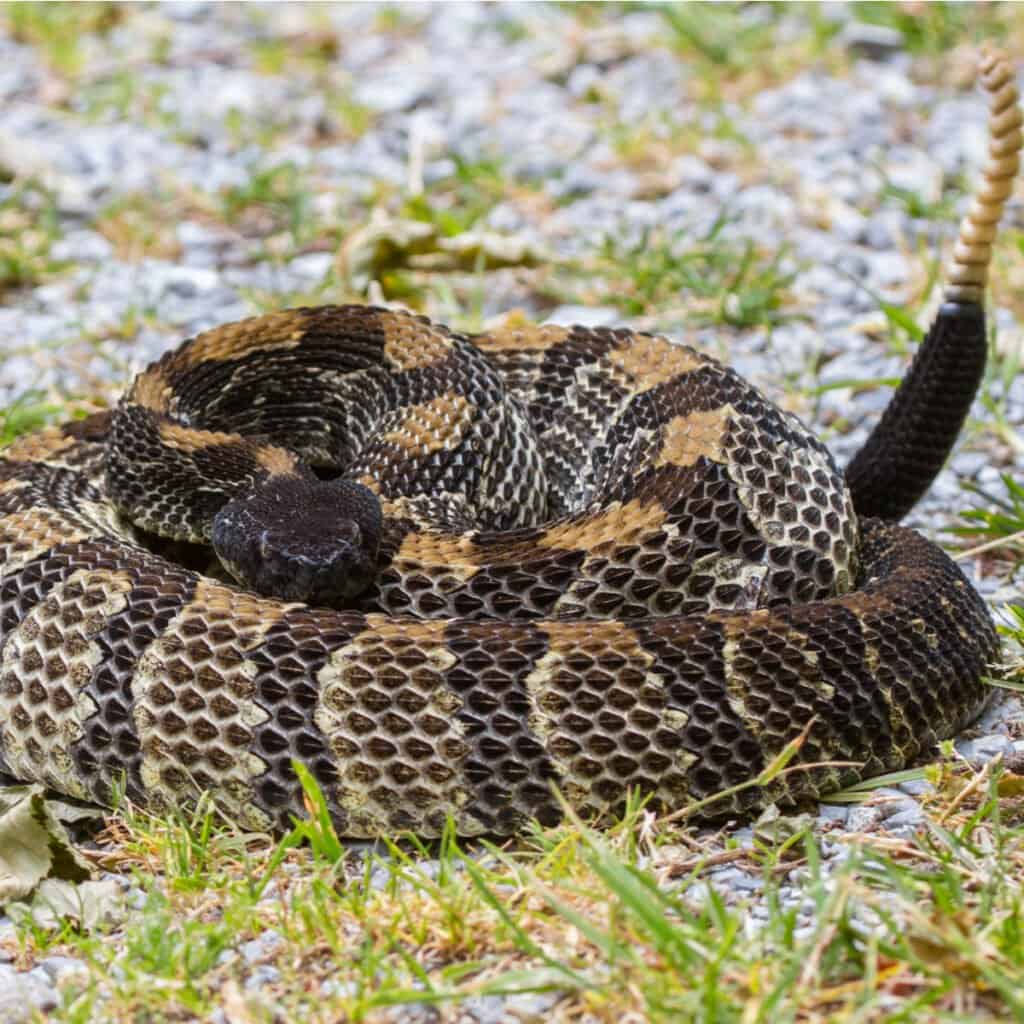
Timber rattlesnakes are highly venomous. It’s best to give them a wide berth.
©Frode Jacobsen/Shutterstock.com
Timber rattlesnakes can grow up to 60 inches long, although the record-breaking longest one reached 74.5 inches. Rattlesnakes can strike a distance equivalent to 2/3 of their body length. About 800 people a year are bitten by rattlesnakes in the United States. Although their venom can be fatal, only a dozen or so people die from their bites each year, because most get timely medical care.
18. Eastern Massasauga (Sistrurus catenatus)
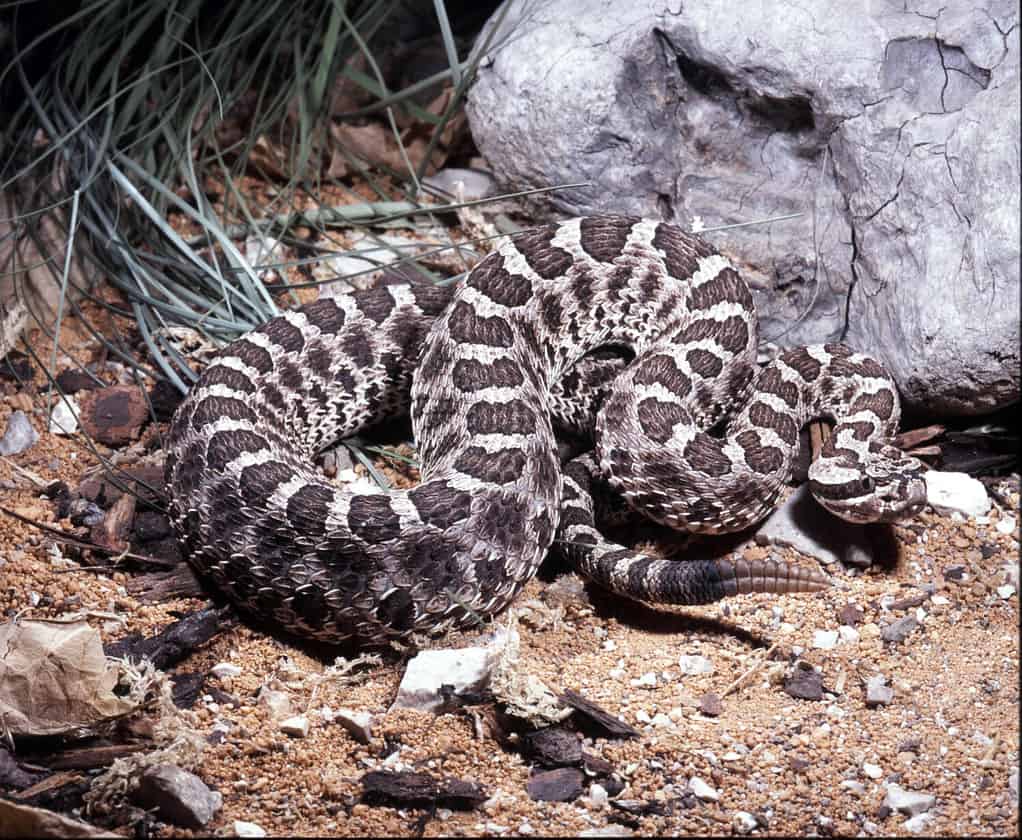
The eastern massasauga is a species of rattlesnake found in the eastern and midwestern United States.
©Vladislav T. Jirousek/Shutterstock.com
The eastern massasauga is a type of rattlesnake that lives in southern Ontario and the eastern and midwestern United States. They are grey or tan with large brown and black spots running down their spines and smaller rows of spots down their sides. Like other rattlesnakes, they are highly venomous.
Dipsadidae Family
Snakes of this family are small and give birth by laying eggs. They have teeth in the back of their jaws. Although their venom is deadly to their prey, it is ineffective and harmless to people.
19. Common Worm Snake (Carphophis amoenus)
The common worm snake lives in woodlands, wetlands, and nearby grasslands. It lives under rocks, logs, leaves, and other rotting debris. It is safe to handle because its mouth is too small to bite anything but earthworms and other small prey. They grow to 11 inches long and are brown or dark brown with a red or pink-tinged belly.
20. Western Worm Snake (Carphophis vermis)
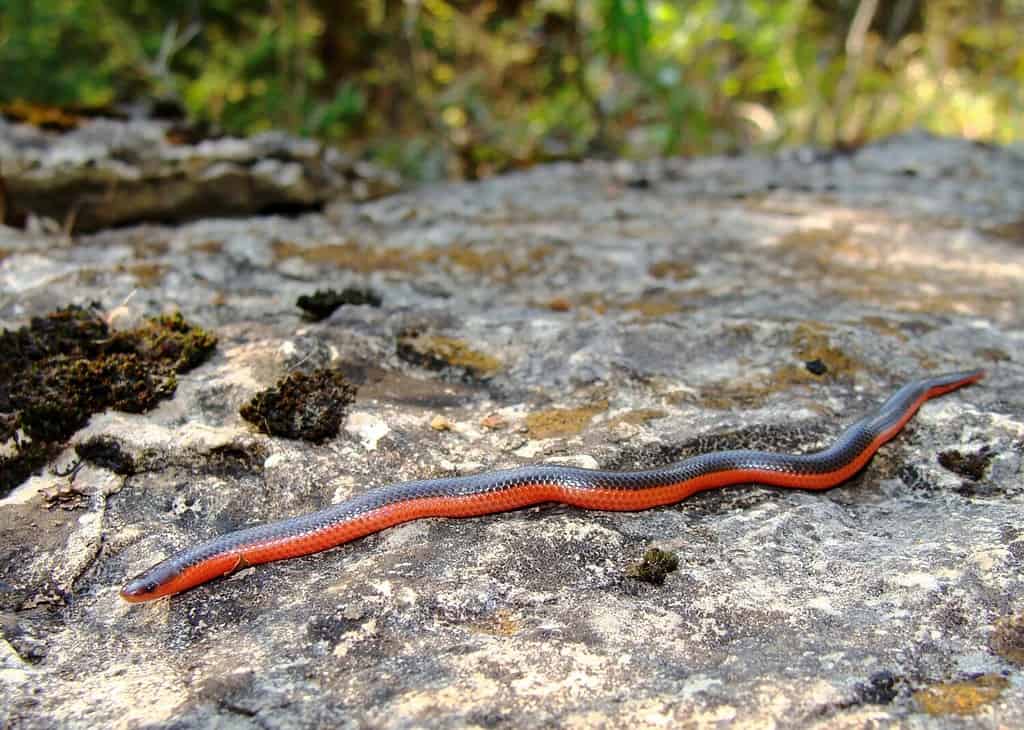
The western worm snake can be distinguished by its red or pinkish underbelly.
©Matt Jeppson/Shutterstock.com
The western worm snake usually grows to 11 inches, but the largest specimen discovered was 14.8 inches long. It has a dark purplish-black back and a pink or reddish underside. It is completely harmless to people.
21. Ring-Necked Snake (Diadophis punctatus)
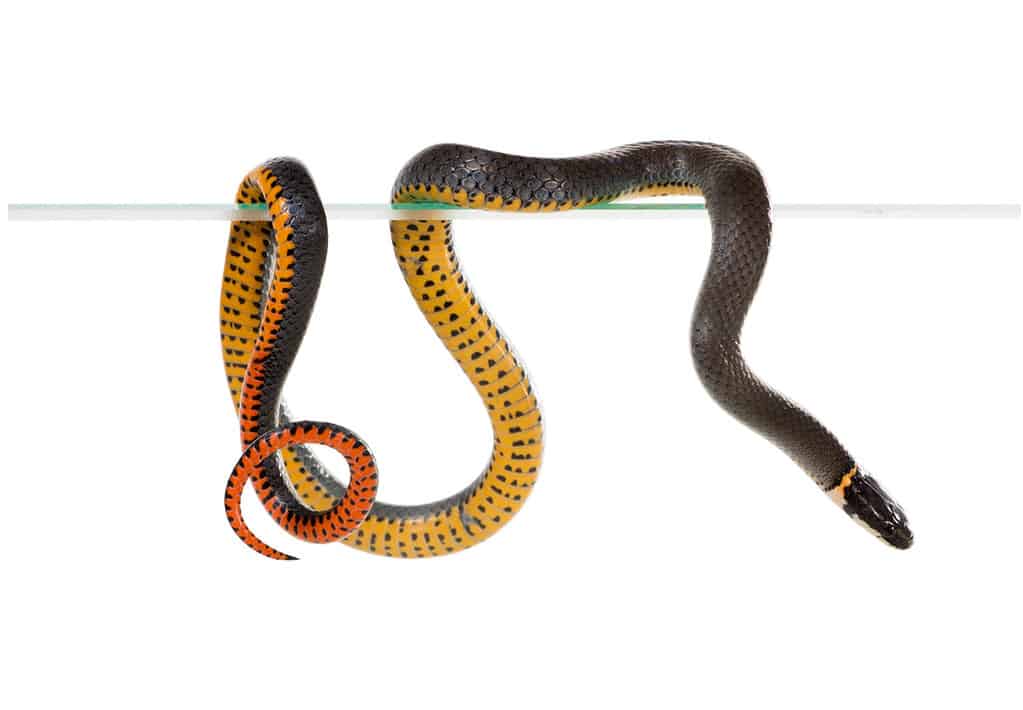
The ring-necked snake has a brightly colored underbelly and a signature ring around its neck.
©IrinaK/Shutterstock.com
The ring-necked snake is a non-venomous nocturnal species that grows up to 15 inches long. It can be colored olive green, brown, bluish-gray, or black with a yellow, red, or orange neckband. One of its distinctive features is its defense mechanism: it curls up its tail to expose its red-orange underbelly when it feels threatened.
22. Red-Bellied Mudsnake (Farancia abacura)
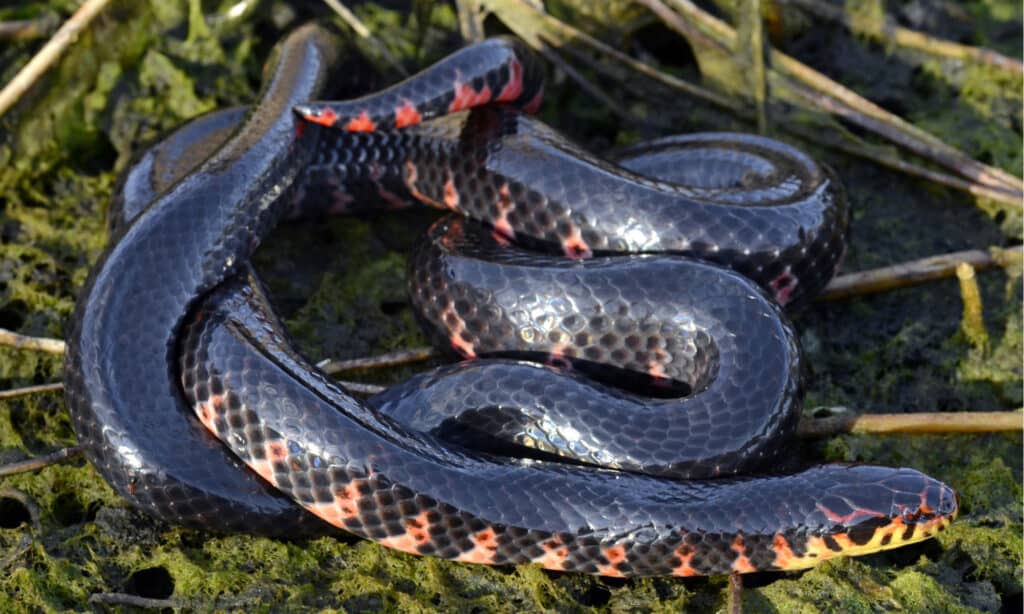
Red-bellied mud snakes can grow to 3-6 feet long.
©Patrick K. Campbell/Shutterstock.com
This is a large snake, growing to 3-6 feet long. They live and hunt near water. They have shiny black scales with a red and black checkerboard pattern on their ventral side. When captured, they try to poke their tormenter with a sharp spine at the end of their tails.
23. Western Hog-Nosed Snake (Heterodon nasicus)
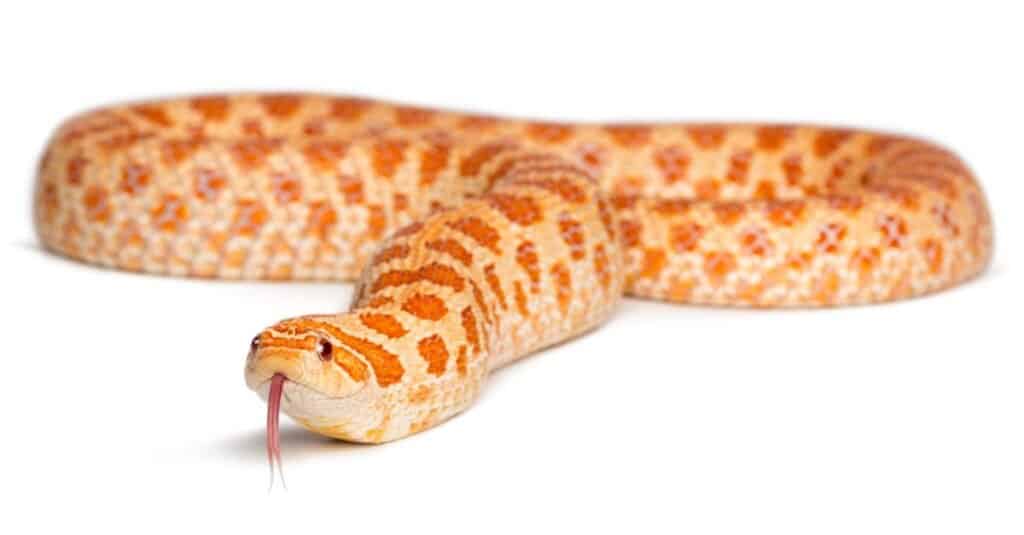
Enthusiasts have bred the western hog-nosed snake into over 50 different colors and patterns.
©iStock.com/GlobalP
The western hognose snake is a small species reaching about 20 inches long. It is named for its upturned nose, used for burrowing. It has a mild venom administered to its prey from fangs placed at the rear of the mouth. Collectors have bred these snakes in captivity into over 50 different colors and patterns.
24. Eastern Hog-Nosed Snake (Heterodon platirhinos)
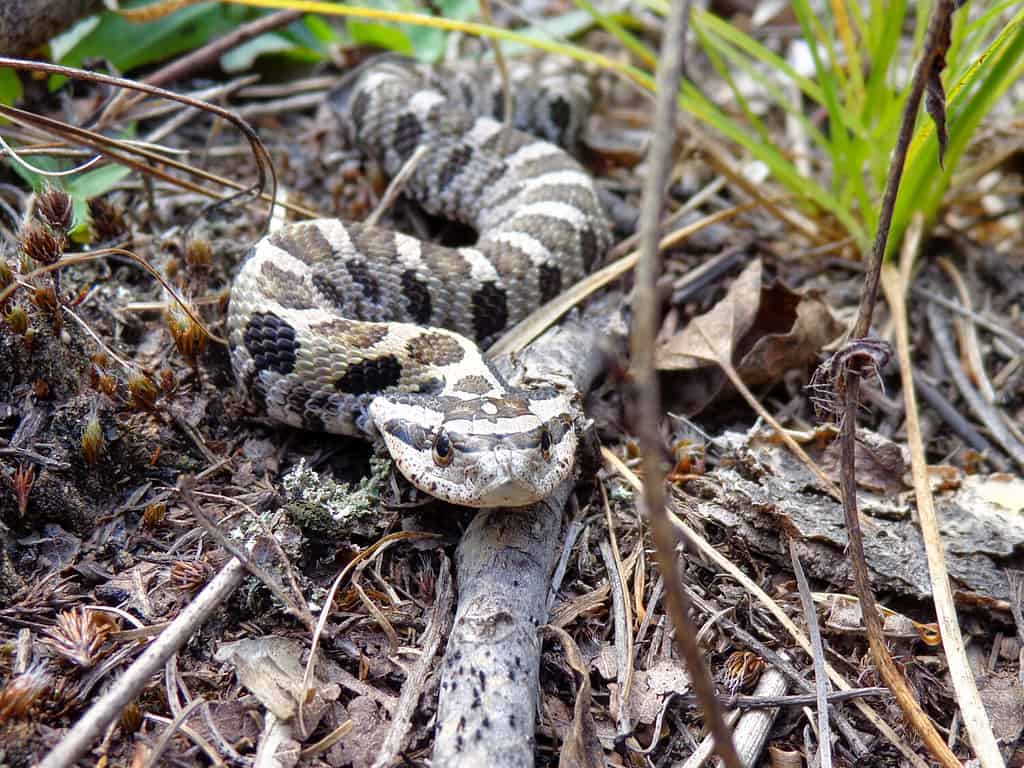
The eastern hog-nosed snake is mildly venomous.
©IHX/Shutterstock.com
These snakes have fangs in the rear of their mouths and are mildly venomous. They can grow to about 28 inches in length, although an unusually long record-breaking specimen measured 46 inches. They come in a lot of different colors and can be plain or have various patterns. An easy way to identify one, though, is by its upturned nose, which is used for digging.
Natricidae Family
The Natricidae are a subfamily of colubrid snakes. These snakes are some of the most common species, such as grass snakes, garter snakes, and water snakes. They live on every continent except Antarctica and South America, though they do extend as far south as Central America. They are usually semi-aquatic and non-venomous.
25. Kirtland’s Snake (Clonophis kirtlandii)
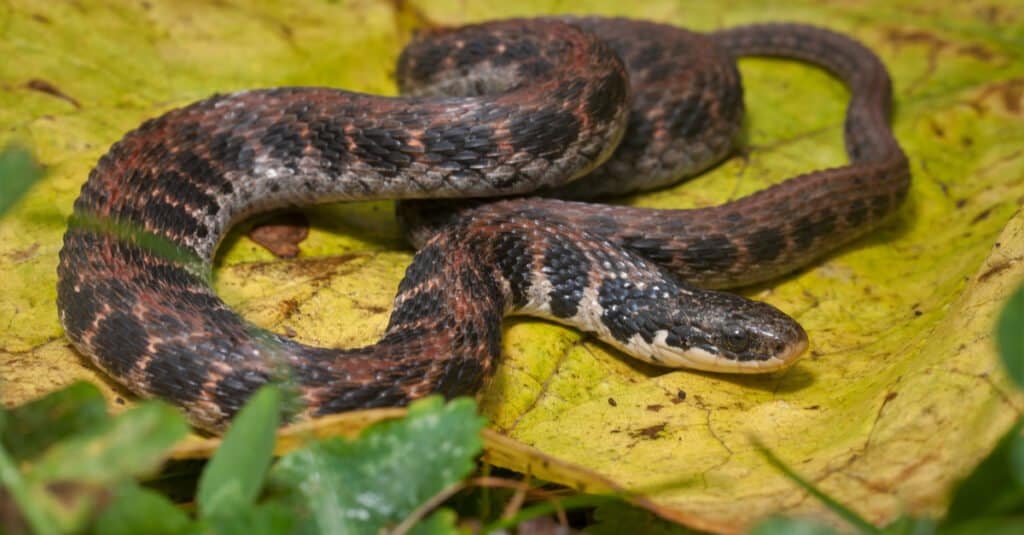
Kirtland’s snake has a reddish-brown coloration and a distinct row of black spots along each side.
©Mike Wilhelm/Shutterstock.com
Kirtland’s snake is a threatened or endangered species. It grows up to 18 inches long and is gray, brown with a double row of black spots along its dorsal side. It also has small spots along each side of its body. Underneath its color is brick red.
26. Mississippi Green Watersnake (Nerodia cyclopion)
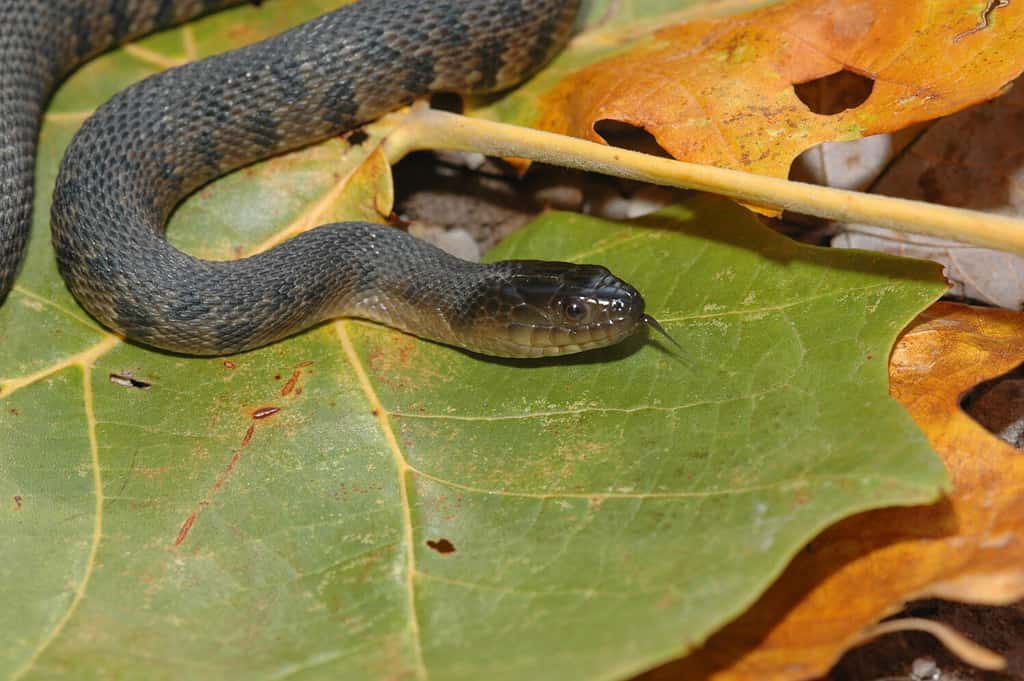
Mississippi green watersnakes are not venomous but they bite viciously when threatened.
©Rusty Dodson/Shutterstock.com
The Mississippi green watersnake is a non-venomous species that defends itself by biting viciously and secreting musk. They are greenish brown with olive-brown or dark-brown splotches. Their bellies are dark gray with yellow half-moon marks.
27. Plain-Bellied Watersnake (Nerodia erythrogaster)
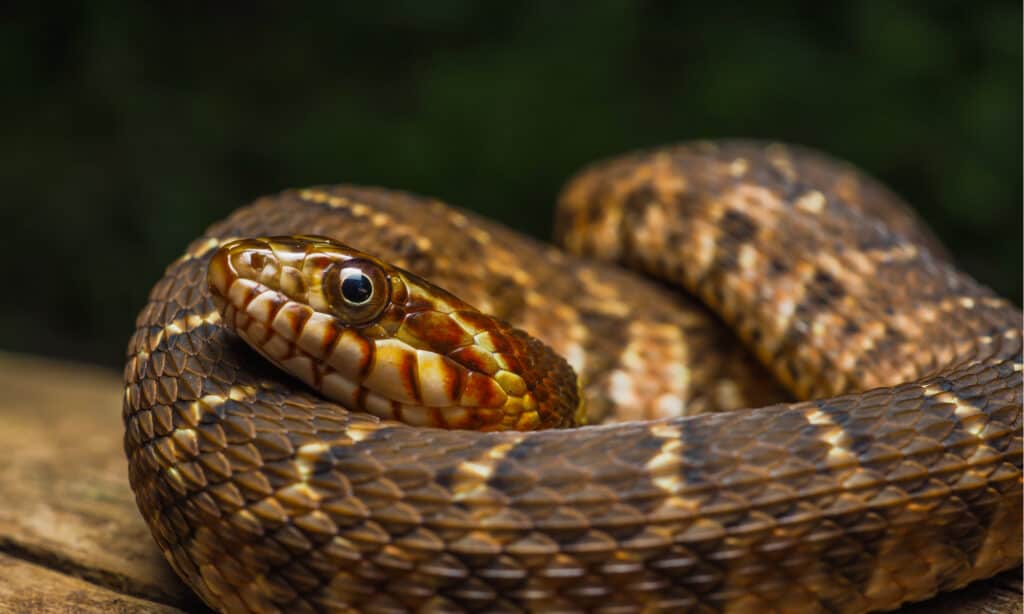
Plain-bellied watersnake gets its name from its plain, unmarked belly.
©Tyler Albertson/Shutterstock.com
We can’t talk about the plain-bellied watersnake without talking about its plain belly. It’s yellow or orange and has no markings. And that’s how this snake got its name. The rest of the snake is gray, greenish, or brownish black. When they’re young they have distinct brown patterns on their backs that help with camouflage.
28. Southern Watersnake (Nerodia fasciata fasciata)
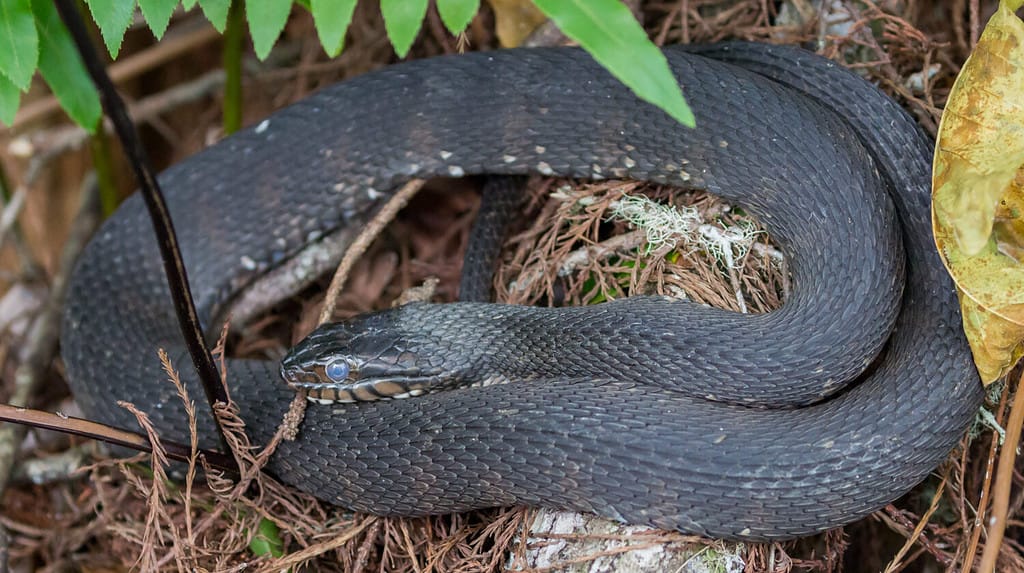
Southern watersnakes live in wetlands and near shallow lakes and ponds.
©EdwinWilke/Shutterstock.com
This type of snake likes to live in wetlands and near shallow lakes and ponds. It grows up to 36 inches long and has bands of brown, red-brown, or black separated by bands. It has a faint line running diagonally from the eye to the corner of the mouth. These snakes are non-venomous.
29. Diamond-Backed Watersnake (Nerodia rhombifer)
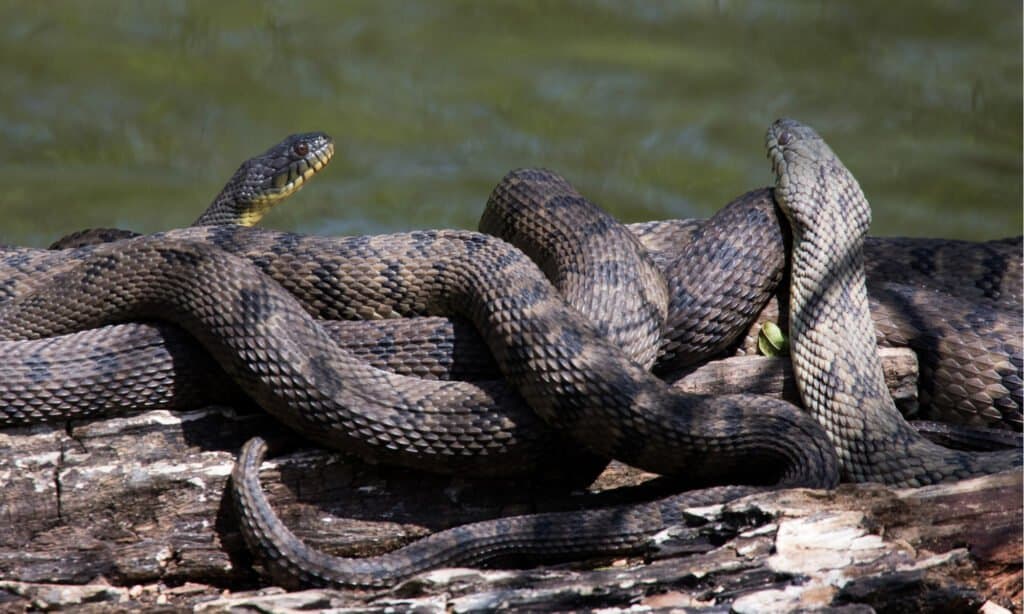
Diamondback watersnakes eat frogs, toads, and salamanders, among other things.
©Laurie L. Snidow/Shutterstock.com
Diamon-backed watersnakes are large and heavy. They are gray, light brown, or dull yellow with darker diamond shapes running along their backs. Their bellies are yellow bordered by rows of dark brown spots. They are non-venomous but defend themselves by flattening their heads and necks to look larger, biting, and releasing musk from their scent glands.
30. Common Watersnake (Nerodia sipedon)
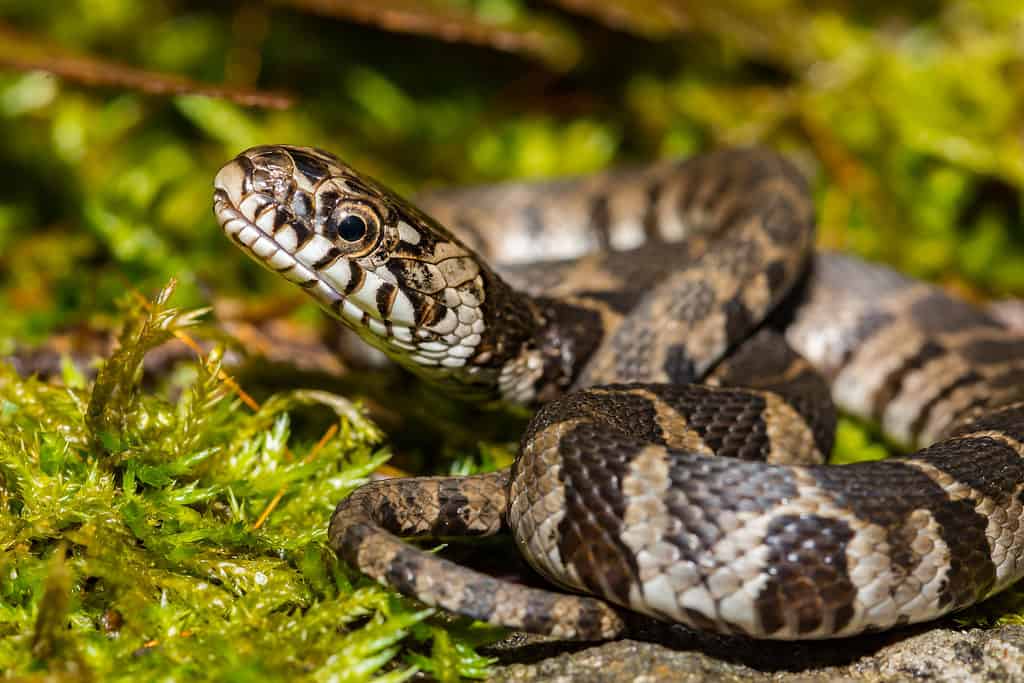
Common watersnakes are large non-venomous snakes often mistaken for cottonmouths.
©Jay Ondreicka/Shutterstock.com
The common watersnake is a large species that can grow up to 4.5 feet long. It is often mistaken for a cottonmouth because of its size and color patterns. It can be brown or brownish-black, gray, or red-tinged. it has dark bands and blotches on its body like the cottonmouth. You can distinguish them by remembering that the cottonmouth is a kind of pit viper, so it has heat-sensing pits between its eyes and nostrils. The common watersnake doesn’t have those.
31. Graham’s Crayfish Snake (Regina grahamii)
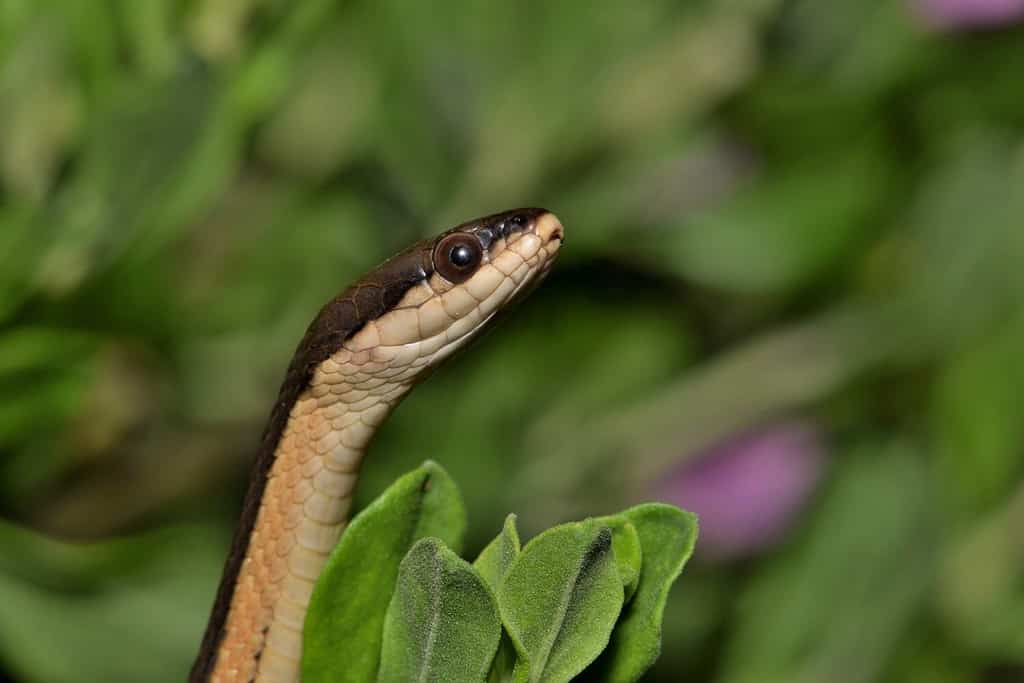
This snake defends itself with feces mixed with a nasty-smelling musk.
©Brett Hondow/Shutterstock.com
This is a medium-sized snake that frequents streams, wetlands, and ponds. It is yellowish-brown with yellowish-tan stripes on its sides. It has a cream or light-yellow belly with grey or light brown spots. This snake is nonvenomous and usually doesn’t bite. However, it defends itself with something even worse when captured: it releases feces mixed with a nasty-smelling musk.
32. Queen Snake (Regina septemvittata)
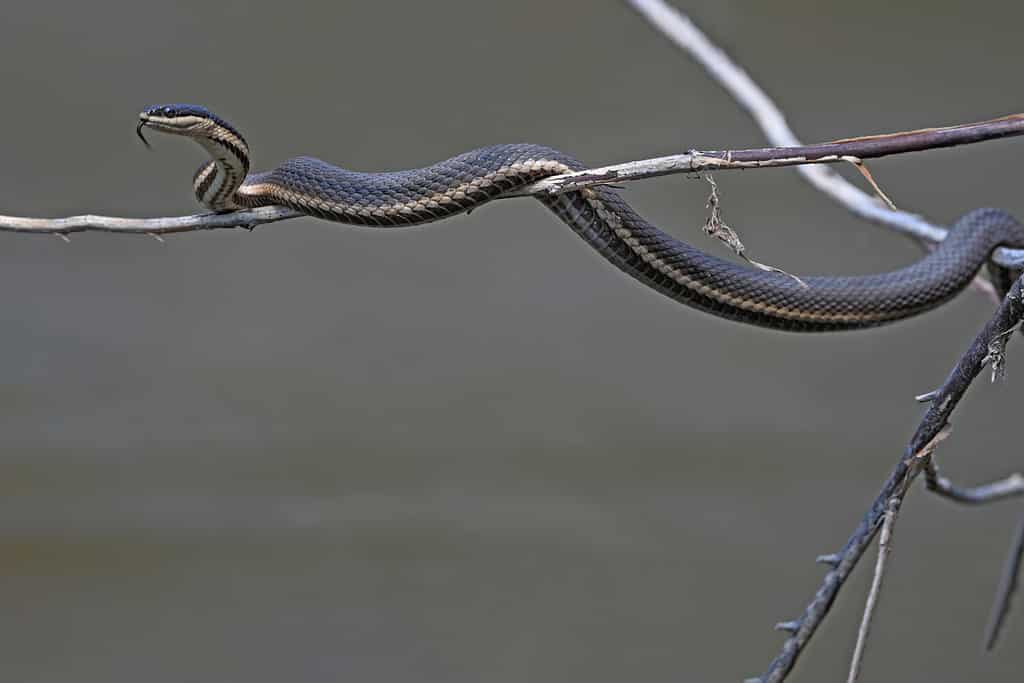
The queen snake is a semi-aquatic species.
©Lev Frid/Shutterstock.com
The queen snake is not venomous. It spends most of its time near or in water, catching its prey. Queen snakes are olive, gray, or brown with pinkish or yellow stripes running down their bodies. The clearest way to identify this snake is from the four stripes running along its belly. This unique feature distinguishes them from any similar species. They grow up to about 24 inches long.
33. DeKay’s Brown Snake (Storeria dekayi)
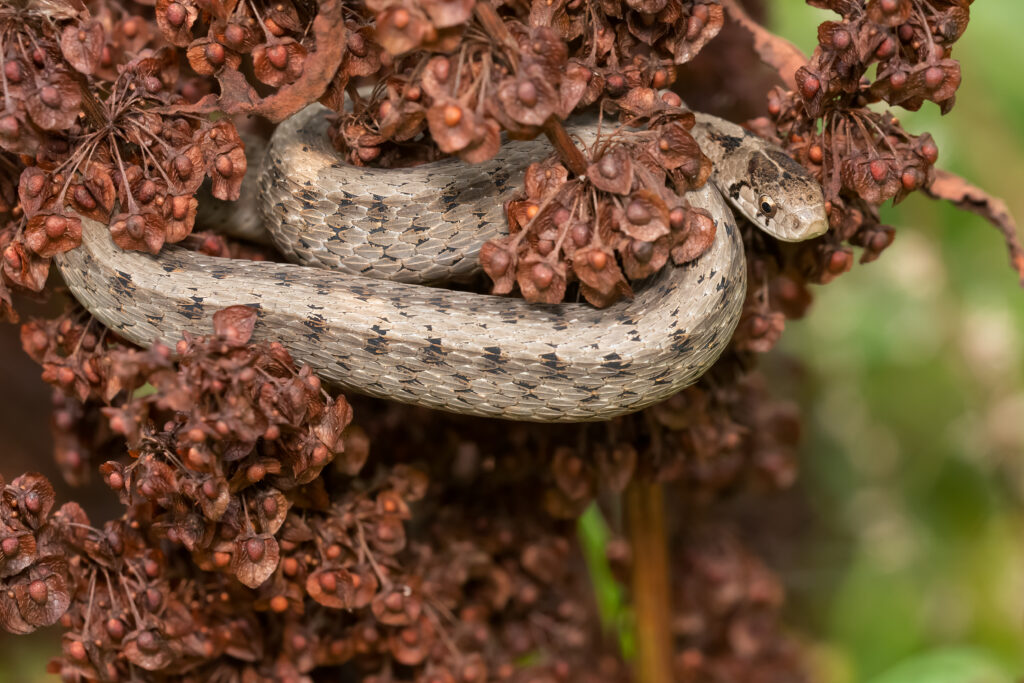
DeKay’s brown snake preys mostly on slugs and earthworms.
©Paul Reeves Photography/Shutterstock.com
People often refer to this snake as simply a “brown snake.” It is non-venomous and feeds mainly on soft-bodied creatures like slugs and earthworms. It is grey with a light center stripe and small black spots. DeKay’s brown snakes typically reach about 12 inches when they are full-grown.
34. Red-Bellied Snake (Storeria ocipitomaculata)
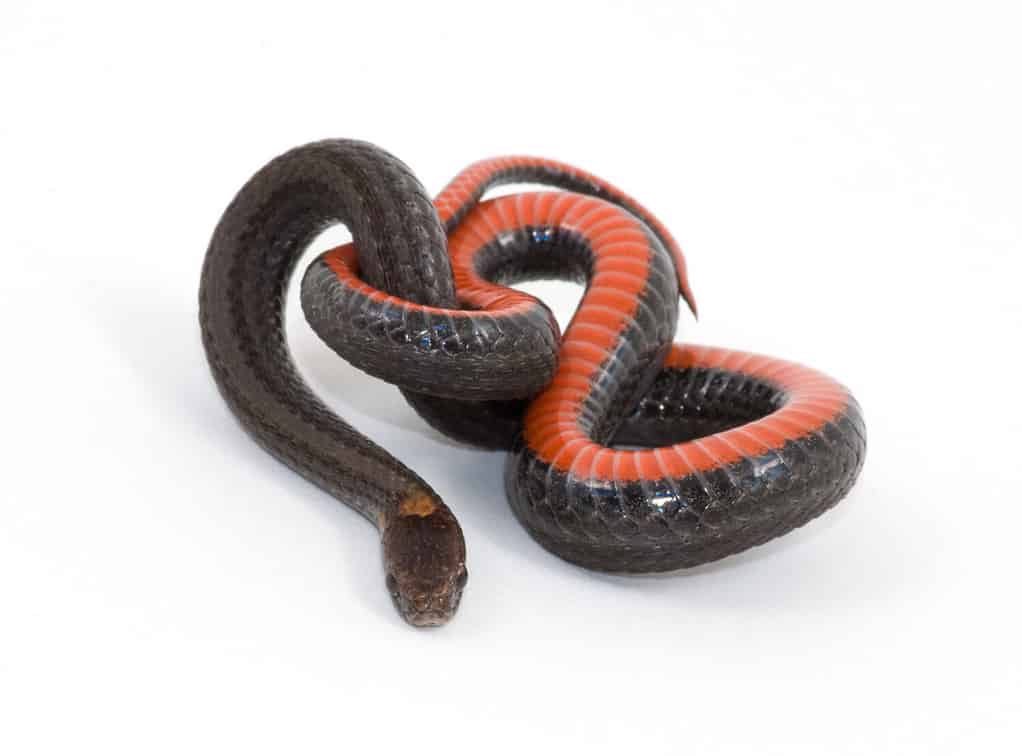
Red-bellied snakes are cousins to Dekay’s brown snake.
©Gerald A. DeBoer/Shutterstock.com
Red-bellied snakes live in woodland areas. They grow up to 10 inches long. They come in a variety of colors: black, grey, brown, or bright orange. Sometimes they have an orange stripe down their spines. Sometimes they have a light brown ring around their necks. Something that distinguishes them is their bright orange or red underbelly.
35. Western Ribbon Snake (Thamnophis proximus)
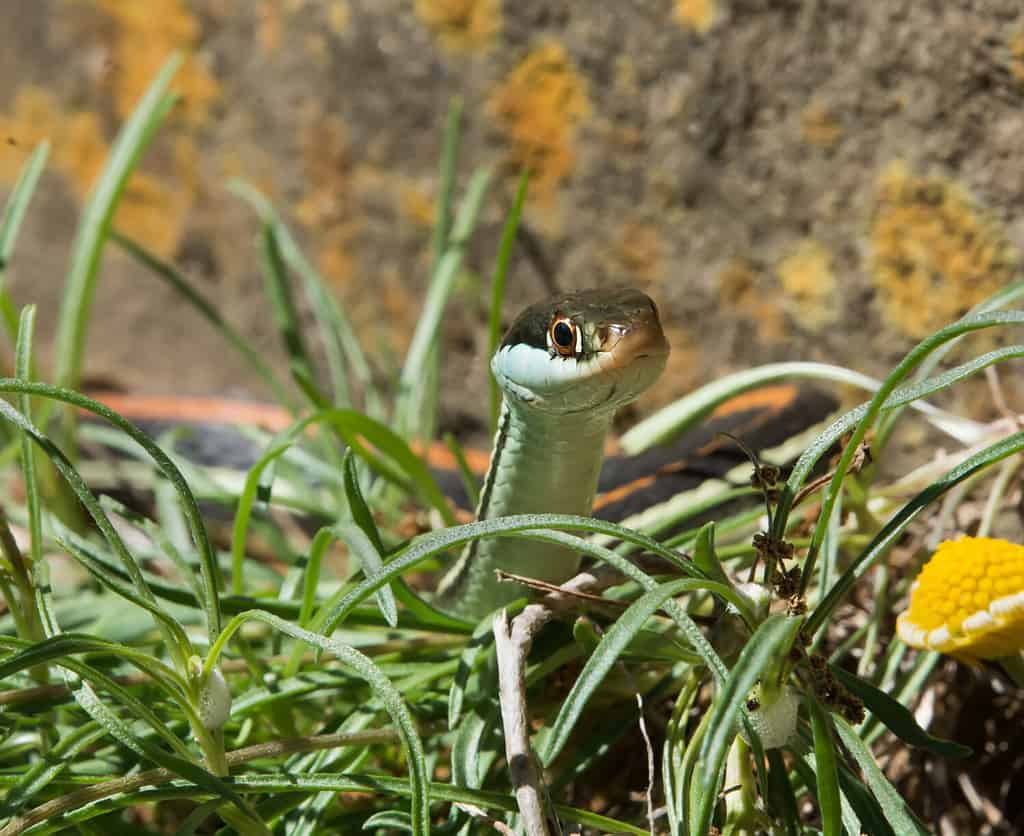
Whether or not you like snakes, you have to admit the western ribbon snake is a little cutie.
©William Cushman/Shutterstock.com
The Western ribbon snake is a black, brown, or olive-green snake with three light stripes. It is light green or yellowish underneath. It is noteworthy for having a long tail, about 1/3 of its total body length. By the way, you could be forgiven for wondering which part is the tail. Aren’t snakes all-tail? Actually, the tail begins at the cloaca or vent where the animal expels waste and reproduces.
36. Plains Garter Snake (Thamnophis radix)
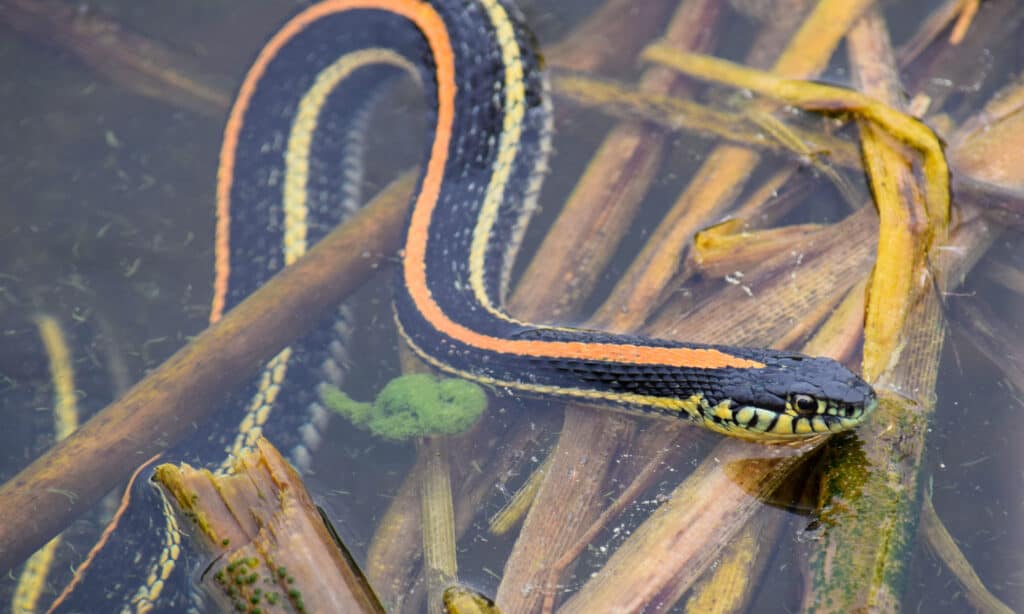
Plains garter snakes usually have a bright orange or yellow stripe on their back.
©Alyssa Metro/Shutterstock.com
The plains garter snake is a grayish-green snake noticeable for the orange or yellow stripe running down its back. They like to hang out around streams and ponds where they can catch insects, amphibians, and other small prey. They are mildly venomous, but only enough to affect small creatures. Humans are not in any danger from their venom.
37. Eastern Ribbon Snake (Thamnophis saurita)
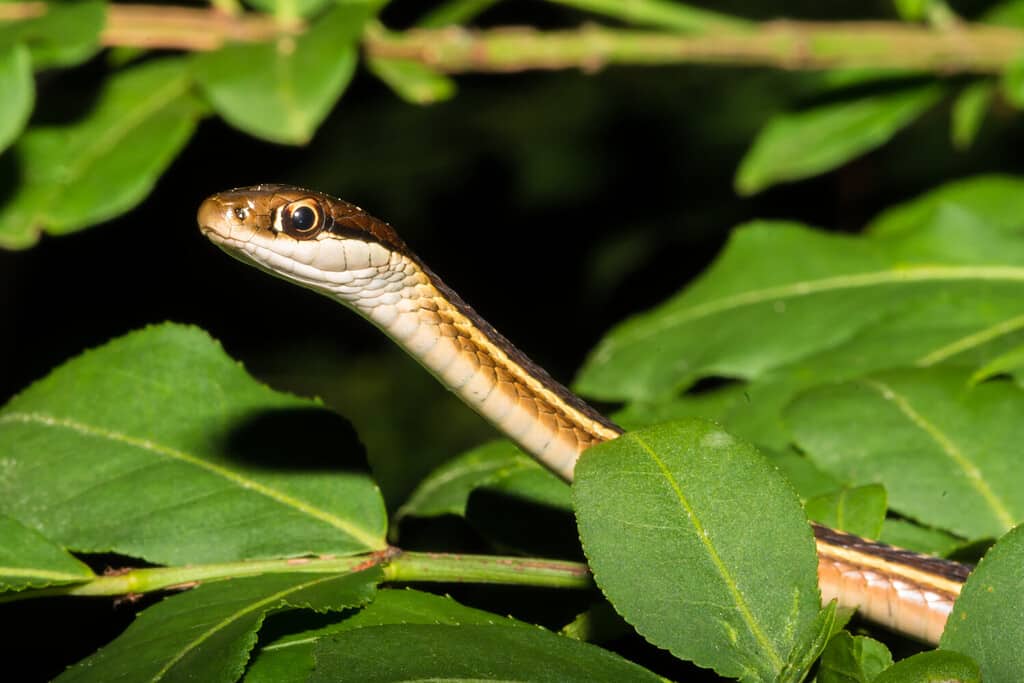
The eastern ribbon snake gets its name from the fact that its body is so long and thin.
©Jay Ondreicka/Shutterstock.com
Eastern ribbon snakes are named for their long, thin bodies. They grow up to about 34 inches long. They’re mainly black with three longitudinal yellow stripes: one down their spine and one on each side. These stripes are yellow, but the snake also has brown stripes on its sides, blending down into a greenish-white belly.
38. Common Garter Snake (Thamnophis sirtalis)

The common garter snake is thin and usually small, though it can get as long as 4 feet.
©Nynke van Holten/Shutterstock.com
Common garter snakes are small, thin snakes that can reach a maximum length of 4 feet. They can come in a variety of colors: green, blue, yellow, gold, red, orange, brown, and black. They have brightly contrasting stripes running down the length of their bodies that also come in a lot of different colors.
39. Lined Snake (Tropidoclonion lineatum)
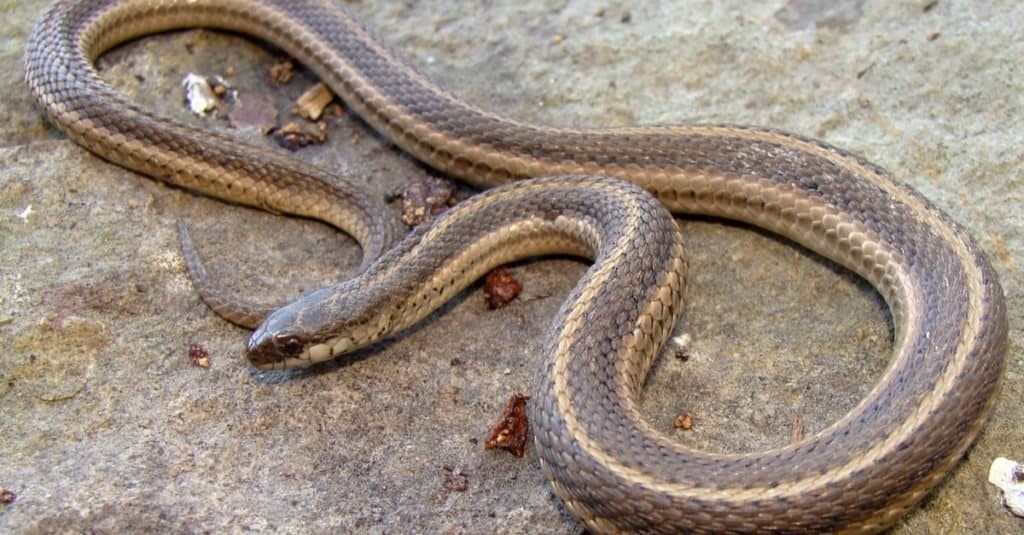
Lined snakes are small and thin and have small heads that are hardly wider than their body.
©Matt Jeppson/Shutterstock.com
Lined snakes go by a great many other common names like dwarf garter snake, grass snake, ribbon snake, streaked snake, striped snake, or swamp snake. Their color ranges from green to brown with sharply contrasting light stripes running down either side of their backs. Their bellies have symmetrical black spots shaped like half-moons running down their length. They grow on average to about 14 inches long.
40. Smooth Earth Snake (Virginia valeriae)
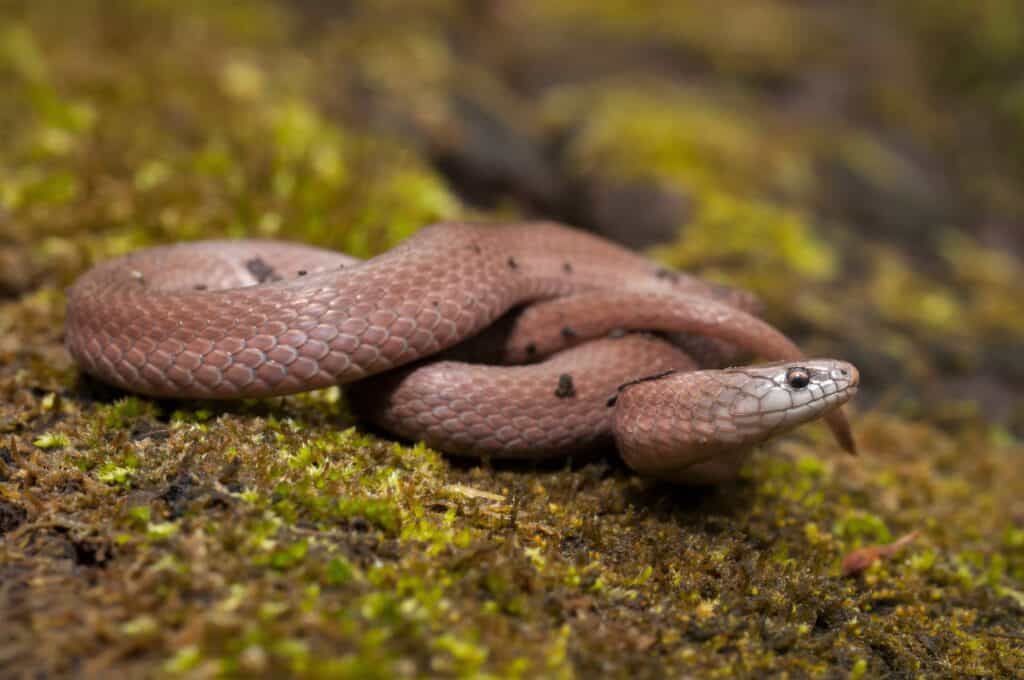
Smooth earth snakes are often mistaken for ring-necked snakes or De Kay’s snakes.
©Mike Wilhelm/Shutterstock.com
Smooth earth snakes are a nonvenomous species that come in shades of brown with light off-white coloration on the lower sides of their faces. They can also have a faint light line down the middle and black spots on their back and sides. They normally grow up to 9.8 inches in length.
That’s a Lot of Snakes!
As you can see, Illinois has a lot of snakes due to a healthy ecosystem that can support diverse wildlife. Given that only four of the 40 species are highly venomous, if you spot a snake in Illinois, nine times out of 10 it will be harmless. Nevertheless, a bite from any snake can create lacerations and cause an infection. So, it is best to admire these reptiles from a distance and give them plenty of space.
Discover the "Monster" Snake 5X Bigger than an Anaconda
Every day A-Z Animals sends out some of the most incredible facts in the world from our free newsletter. Want to discover the 10 most beautiful snakes in the world, a "snake island" where you're never more than 3 feet from danger, or a "monster" snake 5X larger than an anaconda? Then sign up right now and you'll start receiving our daily newsletter absolutely free.
Thank you for reading! Have some feedback for us? Contact the AZ Animals editorial team.

